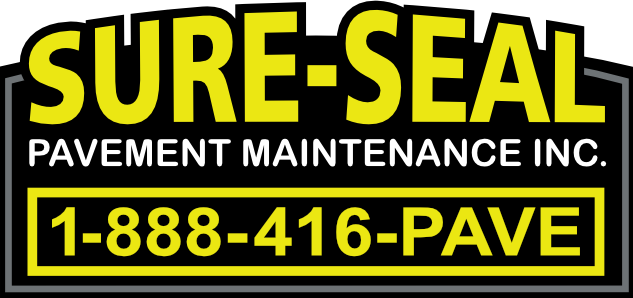Asphalt pavement is one of the most resilient, durable, and commonly used materials for a variety of construction projects. Thanks to its longevity and ability to withstand numerous potentially damaging external elements, asphalt is one of the most popular paving materials for residential and commercial properties worldwide. In fact, asphalt pavement is such a regular fixture of our daily lives (it’s on our roadways, in our parking lots, in our roofing materials, in rubber, and many other everyday items) that we rarely stop to think about the asphalt pavement installation process.
Commercial and residential property owners would benefit from learning about the asphalt paving process, however, because it’s their responsibility to maintain and repair their properties and even occasionally remove and replace the asphalt as needed. Without further ado, here is the tried and true seven-step asphalt pavement installation process implemented by Sure-Seal Pavement Maintenance Inc.
1. Demolish and Remove Existing Asphalt
Before fresh asphalt can be laid, the existing surface—whether it’s concrete, pavers, or asphalt— must be removed. Depending on the size of the property and the age of the asphalt, large equipment like forklifts and bobcats are sometimes used to remove the asphalt and load it into dump trucks. The existing asphalt surface is then recycled and used to make the new mixture in an effort to minimize waste as much as possible.
2. Determine the Grading and Sloping
Next, it’s time to prepare the area where the asphalt is going to be applied. To ensure the structural integrity and strength of the new asphalt pavement and manage water runoff, the area needs to be graded and sloped prior to application.
Standing or pooling water is your asphalt pavement’s worst nemesis as it can cause a lot of potentially expensive damages, so it’s vital to take every precaution to prevent water collection. Grading basically makes the asphalt porous to allow proper water drainage. Then we test the water runoff direction to see which way the water drains. Based on our findings, the next step is to appropriately slope the asphalt by creating strategically placed mounds to create a quarter-inch slope, which is ideal for drainage and structural strength.
3. Prepare and Compact the Sub-Base
To guarantee that your asphalt pavement can withstand various external elements like inclement weather conditions, heavy vehicular traffic, vehicular fluid leaks, etc., it’s essential to start off with a strong sub-base. Basically, the sub-base is a barrier that protects against frost in the winter and provides additional reinforcement and structural support for your asphalt pavement to prevent it from buckling under pressure or forming dips and depressions. Compaction helps create a smooth and even surface while also securing the sub-base in place, making it an important step that shouldn’t be missed or neglected.
4. Pinpoint Potential Weak or Soft Spots
Once the sub-based is applied and compacted, it’s important to test it for potential soft or weak spots that can jeopardize its structural integrity and inevitably shorten its lifespan significantly.
For that reason, Sure-Seal takes the time to proof roll the sub-base. Proof rolling involves using a heavy quad-axel dump truck to go over every square inch of the sub-base surface to test its strength and flexibility. If certain sections of it begin to shift or dip, then we know that the sub-base requires additional reinforcement before the asphalt mixture can be applied. Several solutions can be used to fix this problem, including:
- Undercutting, which involves digging about three feet below the surface of the sub-base and replacing the soil with a much stronger aggregate
- Geo-grid, which entails digging only about 16 inches below the surface of the sub-base and reinforcing or binding the materials together with a connective grid to hold them together.
Both methods are meant to render the same results—a stronger and more supportive foundation for your asphalt—but geo-gridding is the more affordable and less labour-intensive option in the asphalt paving industry.
5. Apply the Binder
After ascertaining a strong and reliable foundation for the asphalt overlay, it’s time to apply the binder that essentially holds the asphalt and the sub-base together. The binder consists of an oil and aggregate base, which makes it extremely durable, resilient, and viscous in its liquid form.
Consider the binder as the mainstay of the entire asphalt surface. Without a strong and fully dry binder, the entire structure could eventually fall apart.
6. Lay Down the New Asphalt Surface
Give the binder some time to fully settle before laying down the new asphalt surface. This can take about 24-48 hours. Once you’re completely sure that the sub-base and the binders are completely cured and have formed a solid foundation, it’s safe to install the asphalt surface.
Asphalt pavement is essentially a mixture of bitumen (the binding agent that gives your asphalt that rich black colour) oil, and fine sand to create a smooth surface. As a result, the finished product is a fresh, attractive, and shiny blacktop that can increase your property’s curb appeal and aesthetic.
7. Smooth Out the Surface Asphalt
Since most asphalt pavements connect two different surfaces (usually parking lots and roadways or driveways and roadways), it’s imperative that the paving contractor takes the time to smooth out the surface of the asphalt. At Sure-Seal, our team of experienced asphalt pavement contractors accomplishes this smooth and completed look by installing butt joints in the transitional portions of the pavement where the old and new surfaces meet. Then, we use a roller truck to further compact and smooth out the newly installed asphalt pavement.
As one of the leading asphalt pavement installation, maintenance, and repairs contractors in Toronto and the GTA, Sure-Seal Pavement Maintenance Inc. takes great pride in the quality of the work that we do. For over 20 years, commercial property owners across the GTA have trusted us to take care of their asphalt pavements. All our work and the materials we use are backed by an extensive seven-year warranty. Contact us today to learn more.

